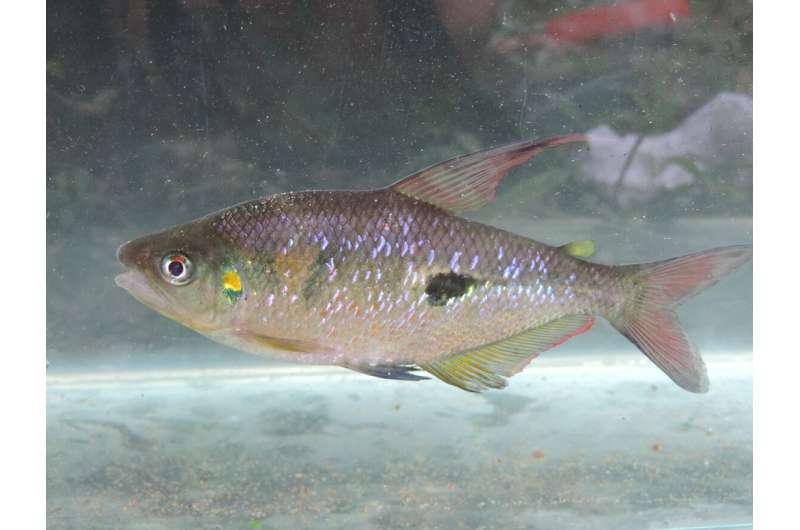Genome of tropical freshwater fish may reveal conservation clues

The genetic evolution of freshwater fish in Ecuador could unlock new insights for conservation ecologists. A new collaboration between biologists and computer scientists at DePaul seeks to sequence the genomes of these species.
"This has the potential to give us real insight into the evolution and adaptation of these fishes, as well as the nature of the planet and the challenges we face," says Windsor Aguirre, an associate professor of evolutionary biology and a co-lead on the project.
Aguirre and Thiru Ramaraj, an assistant professor in the School of Computing, will create a high-quality reference genome for two species of the endemic characid genus Rhoadsia and conduct resequencing of 20 additional specimens. This will not only augment Aguirre's research and contribute to the history of the species, but also be a publicly available resource for researchers around the world who study the evolution of genomes.
"Humans are having an extraordinary effect on the planet, so every species is being forced to respond to humans," Aguirre says. "Every ecosystem has been affected to some degree or another, and many are being affected very severely."
Their research will use next-generation DNA sequencing and bioinformatics to examine why certain species persisted over time but others did not.
Ecuadorian fish hold genetic clues
Aguirre has been researching Ecuador's freshwater fish since 2008 and calls it a "global biodiversity hotspot." Last year Aguirre and his Ecuadorian co-authors published a review in the Journal of Fish Biology on the conservation threats to fisheries in Ecuador—the first comprehensive summary of the status of the fish.
Many labs have access to model genomes such as mouse, rat, fruit fly or zebrafish. Aguirre wanted to take the next step in sequencing the genome of these endemic fish, and in turn create a resource researchers around the world can use to study and investigate the evolution of genomes. He also hopes it will encourage more research on the evolution of freshwater fishes in this important region.
Ramaraj joined DePaul in 2019 and the two met through a bioinformatics group formed by faculty in the Jarvis College of Computing and Digital Media and the College of Science and Health.
"Thiru's expertise in the field of bioinformatics and computation science is incredibly important," Aguirre says. "With advances in technology, it is becoming very easy to generate these large amounts of data. The challenge becomes being able to understand them, and that requires computational tools working at high speed to filter, organize and process very large amounts of data."
In his previous position at a nonprofit biotechnology research institute, Ramaraj was a bioinformatics scientist and worked with next-generation sequencing data for almost a decade. He sequenced data from DNA and RNA across all domains.
"I have collaborated with microbiologists, zoologists, plant and human geneticists, and biochemists," Ramaraj says. He sought to continue that work at DePaul, and the projects with Aguirre was a perfect fit.
Genome sequencing no longer a moonshot
When the first draft of the human genome was published in 2001, Aguirre says it was a significant milestone.
"That was a massive, international effort involving government and private institutions, hundreds of millions of dollars at a massive scale," he notes. Now researchers can create genomes of comparable sizes for a few thousand dollars.
"Something that just 20 years ago was basically the equivalent to a moonshot we can now do in a university setting and tell our students about generating really extraordinary data on the basic evolutionary history of organisms," Aguirre says.
They will generate data using Pacific Biosciences sequencing technology, which produces long, high-quality DNA sequences and uses a computational method to put them back into a complete genome.
"The analogy is taking a book, ripping it apart, and putting it back together," Ramaraj says. "Once we have data, we can mine for interesting patterns, look at where the genes are and understand their function. We can also determine how the genomes themselves are different from closely related species."
Both researchers plan to leverage the project to increase awareness among DePaul students in biology, computer science and other areas about the field of computational biology. Data science can help provide real-world solutions to environmental problems, making it an excellent career path.
"As a computer scientist with this knowledge, you can work for pharmaceutical and plant biotechnology companies," Ramaraj says. "Everything you learn here can be applied in those fields."
More information: Windsor E. Aguirre et al, Conservation threats and future prospects for the freshwater fishes of Ecuador: A hotspot of Neotropical fish diversity, Journal of Fish Biology (2021). DOI: 10.1111/jfb.14844
Journal information: Journal of Fish Biology
Provided by DePaul University



















